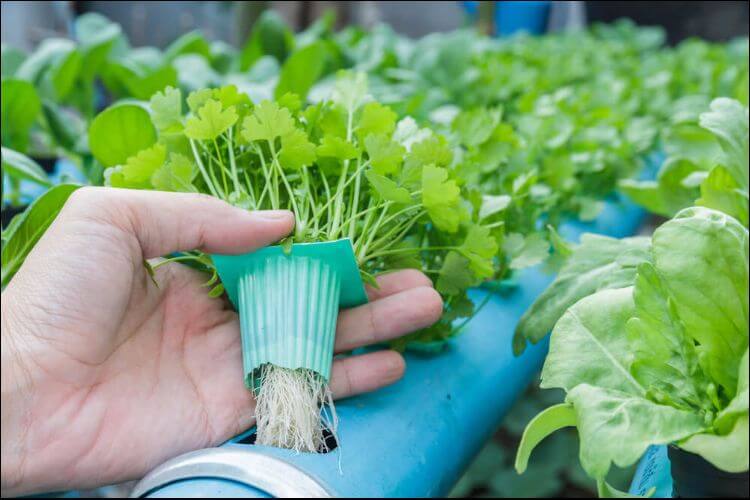Indoor Vegetable Gardening Step by Step
1. Choose the Space
One of the best things about indoor vegetable gardening is that it takes up as much as space as you have. For example, you can start growing tomatoes indoors on a windowsill or a small table. Many people are fans of growing tomatoes in containers, for instance, because in this way they can enjoy them all year round. You can also choose to start indoor vegetable gardening on a table or a bench. In this case, you may want to place it on a floor with a tile or linoleum to catch the drops of water. An alternative is to put a tarp under the table. Shelves are also many gardeners’ favorites. They offer you lots of room for planting without taking up too much space in your home. However, if you decide on this method, you might need to install a grow light for each shelf.
2. Offer the Plants Adequate Light
Growing vegetables indoors with lights can be a little bit complicated, given that plants have different needs. Without the adequate light, a plant will grow tall and spindly. Moreover, you won’t be getting any flowers or fruits either. Even if you place a plant next to the window, it might still need more light in winter. Here are a couple of things you should consider before buying grow lights:- Plants’ photoreceptors only absorb some wavelengths of the light, namely the same as the sun. That’s why you can’t use a normal light bulb.
- You need to set the light as close to the plant as you can, but don’t burn the leaves.
- Most plants (including vegetables) require 14-16 hours of sunlight (or simulated light). Usually, if a plant is not getting enough light, it will have small leaves, a lighter color, as well as thin stems.
- The budding and flowering processes are controlled by a hormone named florigen. Long day plants need 14-18 hours of light to produce the necessary amount of florigen. Meanwhile, short day plants need 10-13 hours. However, if the latter get more light than they need, the florigen will be destroyed.

3. Choose the Right Grow Light
Grow lights are essential for growing vegetables indoors year round. But how can you choose the best ones for your garden? Here you have the types of grow lights you can choose for the plants that can grow indoors without sunlight:- Incandescent Lamps – inexpensive, you can find them at a nursery or hardware store. They’re suitable for growing houseplants, but not an indoor garden.
- Fluorescent Lights – use them for growing herbs or plants that don’t need too much light. Budding or flowering plants don’t like this type because they need more light. Fluorescent lights are also inexpensive and can be found at a local garden supply or hardware store.
- Compact Fluorescent Systems – very bright and efficient, they are smaller and better than the old types of fluorescent lights. They produce less heat, so you can place them closer to the plants.
- High-Intensity Discharge (HID) Bulbs – the brightest lights you can find, being the most efficient. However, they can be quite expensive. For example, just one 1,000-watt bulb equals the light produced by 50 fluorescent lights that have 40 watts. There are several types of these bulbs:
- High-Pressure Sodium – produces a red-orange light that’s good for flowering. They’re economical and you can use only one since they don’t provide the blue light required for growing leaves;
- Metal Halide – gives off a blue-white color that’s good for leafy growth, as well as for keeping plants compact. It’s suitable for starting plants out and it can last for 10,000 hours. You only need these two types of lights for indoor vegetable gardening;
- Mercury Vapor;
- Low-Pressure Sodium.
 How big should your lights be? Here you have a table that can help you choose the best:
How big should your lights be? Here you have a table that can help you choose the best:
| Size of Light (Wattage) | Light Conditions | Area Size | Recommended Height above Plants |
| 400 Watt | No outside light or some sunlight | 5×5” or 8×8” area | 1 – 4 feet |
| 600 Watt | No outside light or some sunlight | 7×7” or 10×10” area | 1.5 – 5 feet |
| 1000 Watt | No outside light or some sunlight | 8×8” or 12×12” area | 2 – 6 feet |
4. Offer the Plants the Adequate Temperature
In general, temperatures of 65 – 75 °F are suitable for indoor vegetable gardening. There can be a variance of 10 °F and the plants will be okay. If the area is too hot, the plants you’re growing will turn small and weak. At the same time, plants that grow in conditions that are too cold will have yellow leaves that fall off.5. Conditions of Humidity
During winter, there is less humidity than in the summer, and the heat in your home isn’t going to help the plants. Check the plants for these low-humidity signs:- Brown tips of the leaves;
- A withered or puckered aspect of the plants;
- Leaves falling off;
- Mist the plants as often as they need (but not hairy-leaved plants);
- Put a tray of water next to the garden and place lava rocks in it to have more surface area for evaporation (but don’t put the plants in the tray);
- Keep the plants closer together to make up a microenvironment that offers high humidity;
- Run a humidifier;
- Get an environmental controller that adjusts to your needs.

6. Using Soil
There are some gardeners who prefer to do indoor vegetable gardening with soil. Remember that the soil you find outside can’t be used. Often, this is too heavy, and it can contain weed seeds or insect pests. Instead, you should find a mix that suits indoor plants. An adequate growing soil will stay loose, and it will drain well. At the same time, it should have plenty of organic matter to retain nutrients and moisture.7. Hydroponics
Practicing hydroponics, or hydroculture refers to knowing how to grow plants in water. Growing vegetables indoor hydroponically means that you won’t be needing any soil. In this way, the nutrients will reach the plants directly. Many people choose to adopt this method because:- Plants grow faster (up to 50%) since they can access water and food easily;
- You can use smaller containers;
- The medium is disease-free, and plants won’t become infected;
- If they do get infected, the disease will be limited to only one, not spread to all of them;
- Before wilting, the plants droop, so you can water them before they get damaged.

8. Choosing the Plants
One of the biggest advantages of indoor vegetable gardening is that you can grow almost anything indoors if it doesn’t get too big. A good recommendation is to plant together species that have similar needs for humidity, light, and water. Here is a table with the types of plants you can choose:| Vegetables | Herbs | Flowers | Fruits |
| Peppers Carrots Salad Greens Onions Kale Tomatoes Chard Beans Bush Cucumbers Bell peppers Hot peppers Turnips | Chives Cilantro Rosemary Catmint Basil Oregano Parsley Lavender Thyme Catnip Wheatgrass Parsnip | Alyssum Geranium Marigold Pansy Petunia Zinnia Begonia Roses Shasta Daisy Candytuft | Strawberries Apples (dwarf varieties) Blueberries Citrus Mandarin Orange |
Can I Use Bokashi Composting for Indoor Vegetable Gardening?
Yes, you can certainly use the bokashi composting setup explained for indoor vegetable gardening. Bokashi composting is a process that uses beneficial microorganisms to ferment organic waste, resulting in a nutrient-rich soil amendment. By properly managing the fermentation in an airtight container, you can minimize odor and pests, making it ideal for indoor gardening.
9. Using Fertilizer
The plants that grow indoors generally need an extra boost of fertilizer or nutrients. Most of the nutrients found in the growing medium will be taken up quickly by the plants or will be leached out while you’re watering them. There are plenty of options you can use when it comes to organic fertilizers and other hydroponic nutrients. It’s best to pay attention to the instructions written on the package. Alternatively, you can make your own compost tea by following these simple steps:- Fill 1/3 of a bucket with finished compost;
- Fill it all with water;
- Let it sit for a couple of hours or days (make sure it doesn’t freeze);
- Strain the mixture into a different container with a cheesecloth and a fine screen;
- Add water to the liquid until it looks like a weak tea;
- Apply the compost tea to the soil.










